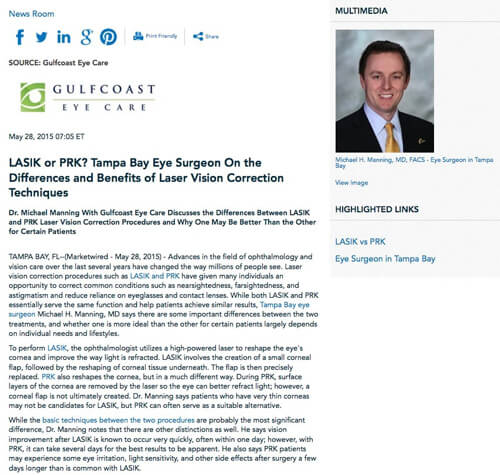Thanksgiving Closure: We will be closed on 11/28-11/29. Happy Thanksgiving from all of us at Gulf Coast Eye Care

News

Dr. Michael Manning with Gulfcoast Eye Care discusses the differences between LASIK and PRK laser vision correction procedures and why one may be better than the other for certain patients.
Tampa Bay, FL – Advances in the field of ophthalmology and vision care over the last several years have changed the way millions of people see. Laser vision correction procedures such as LASIK and PRK have given many individuals an opportunity to correct common conditions such as nearsightedness, farsightedness, and astigmatism and reduce reliance on eyeglasses and contact lenses. While both LASIK and PRK essentially serve the same function and help patients achieve similar results, Tampa Bay eye surgeon Michael H. Manning, MD says there are some important differences between the two treatments, and whether one is more ideal than the other for certain patients largely depends on individual needs and lifestyles.
To perform LASIK, the ophthalmologist utilizes a high-powered laser to reshape the eye’s cornea and improve the way light is refracted. LASIK involves the creation of a small corneal flap, followed by the reshaping of corneal tissue underneath. The flap is then precisely replaced. PRK also reshapes the cornea, but in a much different way. During PRK, surface layers of the cornea are removed by the laser so the eye can better refract light; however, a corneal flap is not ultimately created. Dr. Manning says patients who have very thin corneas may not be candidates for LASIK, but PRK can often serve as a suitable alternative.
While the basic techniques between the two procedures are probably the most significant difference, Dr. Manning notes that there are other distinctions as well. He says vision improvement after LASIK is known to occur very quickly, often within one day; however, with PRK, it can take several days for the best results to be apparent. He also says PRK patients may experience some eye irritation, light sensitivity, and other side effects after surgery a few days longer than is common with LASIK.
Dr. Manning reveals that PRK may be a better option for patients who have a history of dry eye or an irregular curvature to the cornea. He notes that PRK may also be better for those who are involved in hobbies, sports, or occupations that have a high risk of facial trauma because a heavy blow to the eye could possibly damage the corneal flap created during LASIK surgery. But, he says, the important thing to remember is that both treatments have proven many times over to give patients essentially the same results: reduction and even elimination of the need for corrective eyewear.
Dr. Manning says the best thing for individuals who are considering laser vision correction surgery, but are unsure of which procedure is right for them, is to schedule a consultation with a board-certified ophthalmologist and have a comprehensive eye exam. He says, by talking with the doctor and going over all of the options, patients can have their questions answered and make the best possible decision based on their needs and goals.
About Michael H. Manning, MD, FACS
Certified by the American Board of Ophthalmology, Dr. Michael Manning is a Fellow of the American College of Surgeons and a member of the American Society of Cataract and Refractive Surgery, the International Society of Refractive Surgery, the American Academy of Ophthalmology, and other organizations. Dr. Manning is the director of Gulfcoast Eye Care in the Tampa and St. Petersburg, Florida area. The practice is a comprehensive eye and vision care center offering laser vision correction procedures and treatments for an array of eye conditions, including glaucoma, cataracts, diabetic eye disease, dry eye syndrome, and others. Dr. Manning is available for interview upon request.
The practice can be reached online at gulfcoasteyecare.com and facebook.com/gulfcoasteyecare.
Contact:
Gulfcoast Eye Care
Palm Harbor Office
2650 Tampa Rd.
Palm Harbor, FL 34684
Pinellas Park Office
6036 Park Blvd.
Pinellas Park, FL 33781
(727) 346-8696